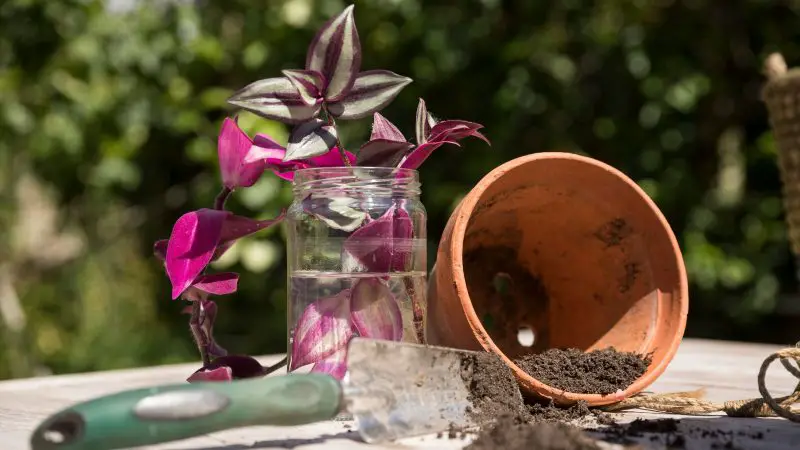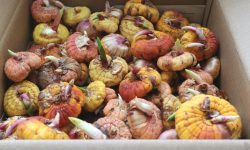Spiderwort is a captivating perennial that brings vibrant color and graceful texture to any garden. Its striking, three-petaled flowers and arching green foliage create a lush, natural display that delights the senses. Beyond beauty, spiderwort is resilient, low-maintenance, and adaptable, making it perfect for both novice and experienced gardeners seeking long-lasting garden appeal.
Propagating spiderwort allows gardeners to expand their collection, rejuvenate older clumps, and share this remarkable plant with friends or community spaces. Understanding proper propagation techniques ensures strong, healthy growth while preserving the plant’s unique characteristics. With careful attention to timing, plant selection, and care, anyone can cultivate thriving spiderwort that offers reliable seasonal blooms, structural elegance, and a vibrant focal point for outdoor spaces.
Understanding about Spiderwort cycle life

Understanding the life cycle of spiderwort is essential for successful propagation and long-term garden care. Spiderwort is a perennial, meaning it lives for multiple years, producing vibrant blooms during its active growing season. Typically, the plant emerges in early spring as temperatures warm, sending up fresh green shoots from underground rhizomes. These shoots develop into dense clumps of foliage that provide both structural beauty and a base for flowering stems. By recognizing the stages of growth, gardeners can plan propagation, pruning, and fertilization to align with the plant’s natural rhythm.
Flowering usually occurs in late spring to early summer, though the exact timing can vary depending on climate and local conditions. Individual blooms last only a day, opening in the morning and fading by evening, yet each stem produces multiple flowers over several weeks. This sequential blooming ensures a prolonged display of color while signaling the plant’s reproductive phase. During this period, spiderwort attracts pollinators such as bees and butterflies, which are critical for seed formation. Understanding this flowering pattern helps gardeners decide the optimal time for taking cuttings or dividing clumps for propagation.
After flowering, spiderwort gradually enters a period of vegetative growth, focusing energy on leaf and rhizome development. As the growing season progresses, older leaves may die back, signaling the plant’s preparation for dormancy. In colder climates, spiderwort dies back to the ground in late fall, with rhizomes remaining protected underground. Gardeners who understand this life cycle can provide appropriate seasonal care, including mulching and soil enrichment, ensuring vigorous regrowth and a healthy, resilient spiderwort population for the following year.
Choosing the Right Time for Propagation
Choosing the right time for propagating spiderwort is crucial for maximizing success and ensuring strong, healthy plants. Spiderwort can be propagated through division, stem cuttings, or seeds, and timing affects each method differently. For division, early spring or late fall is ideal, when the plant is either emerging from dormancy or preparing for rest. During these periods, stress on the plant is minimized, and the new divisions establish quickly in well-prepared soil. Selecting the proper season helps the plant recover faster and produce vigorous growth after transplantation.
Stem cuttings are best taken during the active growing season, usually late spring to early summer. At this time, stems are flexible, healthy, and capable of rooting efficiently. Cuttings taken too early may be underdeveloped, while those taken too late might become woody and resistant to rooting. Gardeners should monitor the plant closely, identifying strong, disease-free stems with at least a few sets of leaves. Proper timing ensures the cuttings have sufficient energy reserves and are more likely to develop robust roots for sustained growth.
Seed propagation has its own timing considerations, generally coinciding with the plant’s natural seed dispersal in late summer or early fall. Collecting seeds at peak maturity ensures higher germination rates and healthier seedlings. Starting seeds indoors before the last frost can give young plants a head start, while sowing directly outdoors allows them to establish naturally. Understanding the life cycle and seasonal growth patterns of spiderwort enables gardeners to plan propagation effectively, resulting in thriving plants and consistent blooms year after year.
Selecting Healthy Parent Plants
Selecting healthy parent plants is a vital step for successful spiderwort propagation. The quality of the parent plant directly affects the vigor, growth rate, and bloom potential of new plants. When choosing specimens, look for strong, disease-free plants with lush green foliage and robust stems. Avoid plants showing signs of stress, such as yellowing leaves, wilting, or pest damage, as these issues can compromise propagation success. Healthy parent plants provide the necessary energy and nutrients to support the development of cuttings, divisions, or seeds.
For division and stem cuttings, focus on mature plants that have established root systems. Older plants with well-developed rhizomes or thick stems are more likely to produce resilient offspring. Examine the plant carefully, ensuring there are no signs of fungal infections or insect infestations. Selecting vigorous stems with multiple leaf nodes and minimal branching enhances rooting potential. By choosing prime specimens, gardeners set a strong foundation for propagated spiderwort, promoting dense foliage, strong stems, and long-lasting blooms.
Seed propagation also benefits from healthy parent plants. Plants that flower abundantly and produce viable seeds increase the likelihood of successful germination. Harvest seeds only from mature, vibrant plants, and avoid those with reduced flowering or poor seed set. Ensuring the parent plant is free from disease or nutrient deficiencies contributes to strong seedlings capable of establishing quickly. By investing time in selecting optimal parent plants, gardeners can maximize propagation success, maintain genetic vigor, and ensure the continued beauty and resilience of their spiderwort collection.
Step-by-Step Propagation Methods
Division Technique
Dividing spiderwort is one of the most reliable propagation methods. Carefully dig around the base of the plant to expose roots. Gently separate the clump into smaller sections, ensuring each division has several shoots and an adequate root system. This method rejuvenates older plants while producing new, viable specimens.
Divisions should be replanted immediately into prepared soil. Water thoroughly to reduce transplant shock and promote root establishment. Spacing is critical to avoid overcrowding, which can limit growth and flowering. Divisions recover quickly when provided with consistent moisture and indirect sunlight during the initial stages.
Regular maintenance after division encourages strong growth. Mulching around new plants helps retain moisture and moderate soil temperature. Fertilization with balanced nutrients supports vigorous shoots, ensuring that divided spiderwort becomes established and blooms reliably.
Stem Cuttings
Stem cuttings are another effective way to propagate spiderwort. Select healthy, non-flowering stems and cut sections of about four to six inches. Remove lower leaves to expose nodes, which develop roots when planted in moist growing medium. Using rooting hormone can enhance success rates.
Place cuttings in a well-draining soil mixture and keep them in a shaded, humid environment. Regular misting maintains moisture, preventing desiccation while roots develop. Avoid direct sunlight, which can stress the cuttings and slow root formation.
After several weeks, roots become visible, indicating readiness for transplantation. Gradually acclimating cuttings to outdoor conditions ensures strong, resilient plants. With proper care, stem cuttings develop into healthy, flowering spiderwort within a growing season.
Seed Propagation
Although less common, propagating spiderwort from seeds can increase genetic diversity. Sow seeds in trays with moist, well-draining soil, lightly covering them. Maintain consistent moisture and moderate temperatures to encourage germination. Germination may take one to three weeks depending on environmental conditions.
Seedlings require careful handling and gradual acclimatization to outdoor conditions. Thin seedlings to prevent overcrowding and ensure adequate airflow. Fertilization supports early growth, producing vigorous young plants ready for garden transplantation.
Seed propagation allows gardeners to experiment with color variations and cultivate new plants. While slower than divisions or cuttings, it is valuable for long-term garden planning and expanding collections sustainably.
Advanced Propagation Techniques
Division of Mature Plants
Dividing mature spiderwort plants is a highly effective propagation technique that allows gardeners to increase plant numbers while maintaining vigor. Begin by carefully digging up the parent plant to avoid damaging the root system. Use a clean, sharp tool to separate the clump into smaller sections, each with a healthy portion of roots and shoots. Choosing strong, disease-free divisions ensures that new plants establish quickly and develop into robust specimens. This method not only multiplies the plants efficiently but also rejuvenates older clumps, encouraging denser foliage and more abundant blooms in the parent plant.
Once divided, replant each section immediately in well-prepared soil rich in organic matter and with good drainage. Water thoroughly to help roots settle and provide partial shade for a few days to reduce transplant shock. Monitoring the divisions closely for the first few weeks ensures they adapt well to their new environment. Over time, these carefully propagated plants will develop strong root systems, maintain the natural mound shape characteristic of spiderwort, and produce vibrant flowers, contributing both aesthetic appeal and long-term resilience to your garden.
Root Cuttings
Root cuttings provide an excellent alternative method for propagating spiderwort, particularly during the plant’s dormant season. Begin by selecting thick, healthy roots free from disease or damage. Using a clean, sharp knife, cut the roots into sections approximately 2–4 inches long, ensuring each piece has sufficient stored energy to support new growth. Plant the cuttings horizontally in a moist, well-draining medium, such as a mix of sand and peat, to encourage root development while minimizing the risk of rot. This propagation technique is especially useful for gardeners looking to preserve the genetic traits of a specific parent plant.
Maintaining consistent moisture is key for successful root cuttings, but overwatering must be avoided to prevent fungal problems. Covering the medium with a clear dome or plastic wrap can help retain humidity while allowing airflow. Root cuttings usually take several weeks to produce visible shoots. Once new growth emerges, gradually acclimate the plants to natural sunlight and outdoor conditions. With careful attention during the early stages, root cuttings develop into strong, healthy spiderwort plants capable of thriving in gardens, ensuring both increased numbers and genetic consistency.
Caring for Propagated Spiderwort
Watering Needs
Proper watering is crucial for successful spiderwort propagation. Newly divided plants, cuttings, or seedlings require consistent moisture to establish strong roots. Too little water can cause stress, wilting, and poor root development, while excessive water may lead to root rot or fungal infections. Maintaining a balanced watering routine ensures that young spiderwort plants receive the hydration needed for vigorous growth without compromising their health.
Gardeners should monitor the soil regularly, keeping it evenly moist but not waterlogged. For cuttings, lightly misting the leaves can help reduce stress and prevent desiccation while roots develop. Established divisions benefit from deep watering once or twice a week, depending on local climate and soil conditions. Proper watering supports nutrient uptake, encourages strong foliage, and promotes abundant flowering. By paying careful attention to moisture needs, gardeners can help propagated spiderwort thrive and establish quickly in the garden, ensuring long-term success and vibrant seasonal blooms.
Fertilization Practices
Fertilization plays a key role in supporting healthy growth of newly propagated spiderwort. Young plants benefit from a balanced, slow-release fertilizer that provides essential nutrients without overwhelming delicate roots. Applying fertilizer at the right time encourages strong leaf development, sturdy stems, and abundant flowering. It is important to follow recommended rates, as over-fertilization can damage tender cuttings or seedlings and reduce overall plant vigor.
For established divisions or seedlings that have rooted successfully, periodic feeding with a liquid fertilizer every four to six weeks can enhance growth and bloom production. Organic options, such as compost tea or diluted fish emulsion, provide nutrients while improving soil structure and microbial activity. Proper fertilization supports the plant’s energy for root expansion, leaf growth, and flower formation. Combined with appropriate watering and sunlight, a consistent fertilization regimen ensures propagated spiderwort develops into strong, thriving plants that will continue to provide color and beauty throughout the growing season.
Pruning and Maintenance
Using Weak or Diseased Plants
Using weak or diseased plants for spiderwort propagation can significantly reduce the chances of success. Cuttings or divisions taken from unhealthy specimens are more likely to fail to root, produce stunted growth, or succumb to infections. Signs of weakness include yellowing or wilted leaves, brittle stems, or visible pest damage. Selecting plants with strong, flexible stems and vibrant foliage ensures that new plants have the energy and resilience needed to establish quickly and grow vigorously.
Diseased plants may carry fungal infections, bacterial problems, or viruses that can spread to the propagated offspring. Using only robust, healthy specimens reduces this risk and promotes long-term garden health. Inspecting the parent plant thoroughly before propagation helps prevent introducing problems into new plantings. By prioritizing strong, disease-free spiderwort for propagation, gardeners can maximize the survival rate, encourage lush growth, and enjoy reliable, abundant blooms throughout the growing season, ensuring both immediate success and long-term sustainability.
Ignoring Environmental Conditions
Ignoring environmental conditions during spiderwort propagation can greatly affect plant survival and growth. Factors such as temperature, humidity, and light exposure play a critical role in root development and overall vigor. Cuttings or seedlings exposed to extreme heat, frost, or insufficient light may experience stress, slowed growth, or failure to establish. Providing a stable, suitable environment ensures that young plants can focus energy on rooting and developing strong foliage.
Humidity and airflow are equally important. Maintaining moderate humidity prevents cuttings from drying out, while proper ventilation reduces the risk of fungal infections and mold. Overcrowding can create damp, stagnant conditions that hinder growth and promote disease. Positioning propagated spiderwort in areas with indirect sunlight or using protective covers can shield delicate cuttings while still providing necessary light. Paying attention to environmental conditions increases propagation success, produces vigorous, healthy plants, and establishes a strong foundation for long-term growth and abundant seasonal blooms.
Overcrowding and Poor Spacing
Overcrowding and poor spacing are common mistakes that can hinder the successful propagation of spiderwort. When cuttings or divisions are planted too closely together, they compete for essential resources such as light, water, and nutrients. This competition can lead to weak, leggy growth, slower root development, and reduced overall vigor. Proper spacing ensures that each plant has access to adequate resources, allowing it to establish quickly and grow into a strong, healthy specimen.
In addition to resource competition, overcrowded conditions increase the risk of disease. Poor airflow between densely packed plants creates a humid environment that encourages fungal growth and pest infestations. Adequate spacing promotes air circulation, helping leaves dry quickly and reducing the likelihood of infections. Gardeners should follow recommended spacing guidelines based on plant size and growth habit to optimize health and flowering potential. Maintaining proper spacing from the start enhances survival rates, encourages dense foliage, and supports abundant blooms, ensuring that propagated spiderwort thrives throughout the growing season and remains visually appealing in the garden.
Troubleshooting and Recovery
Addressing Root Rot
Root rot is a common problem when spiderwort cuttings or divisions are exposed to overly wet conditions. Signs include yellowing leaves, wilting, and a foul odor from the soil. Early detection is key to saving the plant. Gently remove affected plants from the soil and inspect the roots. Trim away any soft, blackened, or mushy roots using sterilized scissors to prevent spreading the disease further.
After trimming, replant in fresh, well-draining soil, ensuring the roots have room to breathe. Adjust watering schedules to avoid waterlogged conditions, and consider using containers with drainage holes to prevent recurring issues. Proper root care and drainage restore the plant’s health and enable it to recover and develop new, vigorous roots. Vigilance and preventive measures can minimize the risk of root rot in future propagation efforts.
Recovering from Pest Infestations
Spiderwort can occasionally attract pests such as aphids, spider mites, or thrips, which can weaken young cuttings or divisions. Early signs include distorted leaves, sticky residues, or webbing on stems. Regular monitoring helps detect infestations before they spread. For minor issues, gently spraying the plants with water can dislodge pests and reduce damage.
For more severe infestations, natural solutions like insecticidal soap or neem oil provide effective control without harming beneficial insects. Isolating affected plants prevents pests from spreading to healthy specimens. Maintaining proper spacing, healthy foliage, and consistent care enhances the plant’s resilience. Addressing pest problems promptly ensures propagated spiderwort can recover fully and continue producing strong stems and abundant blooms.
Reviving Stressed or Wilting Plants
Stress in spiderwort often results from environmental changes, improper watering, or nutrient deficiencies. Wilting, leaf curling, and slowed growth indicate the plant needs immediate attention. Begin by assessing water, light, and soil conditions. Adjust watering to maintain consistent moisture, provide indirect sunlight, and check soil pH and fertility.
Pruning damaged or dead leaves allows the plant to focus energy on recovery. Applying a diluted, balanced fertilizer can stimulate new growth and improve vigor. Gradually acclimating the plant to its intended location helps prevent shock. By taking proactive steps, gardeners can revive stressed spiderwort, encouraging it to develop strong roots, healthy foliage, and eventually, thriving blooms that enhance the garden’s visual appeal.
Correcting Nutrient Deficiencies
Spiderwort plants may show stunted growth, pale leaves, or reduced flowering when they lack essential nutrients. Nitrogen deficiency often results in yellowing foliage, while insufficient phosphorus limits root development and flower production. Potassium shortages can cause weak stems and poor overall vigor. Identifying symptoms early allows gardeners to correct deficiencies before the plant suffers long-term damage.
Applying a balanced, slow-release fertilizer or incorporating organic compost enriches the soil and supplies essential nutrients. Foliar feeding with diluted liquid fertilizer can also provide a quick nutrient boost. Regularly monitoring soil fertility and adjusting care routines ensures that propagated spiderwort remains healthy. Adequate nutrition strengthens the plant’s resilience against environmental stresses, promotes lush foliage, and maximizes bloom production, supporting a successful propagation process and sustained seasonal beauty.
Combating Leaf Spot and Fungal Diseases
Leaf spot and other fungal infections are common in humid or poorly ventilated conditions. Symptoms include dark, circular spots on leaves, wilting, and premature leaf drop. Left untreated, fungal diseases can weaken the plant and reduce flowering potential. Removing affected leaves and improving airflow around the plant helps prevent further spread.
Applying fungicides or natural remedies, such as neem oil, can control outbreaks. Avoiding overhead watering and keeping soil surface dry minimizes fungal growth. Maintaining clean tools and properly spaced plants reduces infection risk. By addressing fungal problems promptly and following preventive measures, gardeners can protect propagated spiderwort, ensuring healthy foliage, strong stems, and continued seasonal blooms.
Reviving Sun- or Shade-Stressed Plants
Spiderwort requires a balance of sunlight and protection from extreme conditions. Plants exposed to too much direct sun may develop scorched leaves, while those in excessive shade can grow leggy and produce fewer flowers. Observing light exposure and relocating stressed plants can help restore vigor.
Gradual acclimation to proper light conditions allows plants to recover without shock. Supplementing with temporary shade cloth or adjusting garden placement provides protection from environmental extremes. Combined with proper watering and care, this approach revitalizes spiderwort, encouraging strong growth and abundant flowering. Careful monitoring and timely adjustments ensure that propagated plants thrive, even after stress.
Recovering from Overwatering Stress
Overwatering can lead to drooping, yellowing leaves, and root suffocation in spiderwort. Excess water reduces oxygen in the soil, causing stress and slowing growth. Temporarily reducing watering and allowing soil to dry helps plants recover and prevents further damage.
Improving drainage with amended soil or raised beds ensures long-term success. Checking containers for adequate drainage and spacing plants properly reduces water accumulation. Proper monitoring and gradual adjustment of watering routines restore plant health, strengthen root systems, and support lush, vibrant foliage. By managing overwatering stress effectively, gardeners increase the survival rate of propagated spiderwort and maintain thriving blooms.
FAQ About How to Propagate Spiderwort
What is the best time of year to propagate spiderwort?
The ideal time for propagating spiderwort is during the active growing season, typically in spring or early summer. During this period, the plant produces vigorous stems and healthy roots, which increases the success rate of cuttings or divisions. Propagation during dormancy is less effective because growth slows and root development is minimal.
Can spiderwort be propagated from stem cuttings?
Yes, stem cuttings are a common and effective method. Choose healthy, non-woody stems with several nodes. Remove lower leaves and place the cutting in moist, well-draining soil or water until roots develop. With proper light, humidity, and temperature, the cutting will establish into a new plant capable of thriving in the garden.
How often should propagated spiderwort be watered?
Newly propagated spiderwort requires consistent moisture to establish strong roots. Water thoroughly but avoid waterlogging, as excess moisture can cause rot. As the plant grows, allow the soil surface to dry slightly between waterings. Monitoring soil moisture regularly ensures healthy root development, dense foliage, and vibrant flowers while preventing disease.
What soil conditions support successful propagation?
Spiderwort prefers well-draining soil rich in organic matter. Sandy loam or a peat-based medium works best for cuttings and divisions. Good drainage prevents root rot while nutrient-rich soil promotes rapid growth and abundant flowering. Adding compost or organic amendments helps maintain soil fertility, supporting long-term health and garden resilience.
How can I prevent disease in propagated plants?
Preventing disease starts with using healthy, pest-free cuttings or divisions. Avoid overcrowding and maintain proper spacing to ensure adequate airflow. Keep foliage dry when watering and remove any decayed leaves promptly. Using clean tools and sterilized pots or soil minimizes the risk of fungal or bacterial infections in young spiderwort plants.
Conclusion
Propagating spiderwort requires careful attention to timing, plant selection, and environmental conditions. Divisions, stem cuttings, and seeds each offer unique advantages. Proper watering, fertilization, and pruning support strong establishment and abundant flowering. Avoiding common mistakes maximizes success and ensures thriving growth. By following expert guidance, gardeners can expand their spiderwort collection efficiently. Each step contributes to healthy, resilient plants that enhance garden beauty and ecosystem diversity. With patience and diligence, propagated spiderwort becomes a long-lasting, vibrant addition to any garden, offering reliable seasonal blooms and structural interest.






